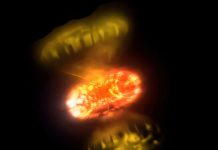
Astronomers using NASA’s Chandra X-ray Observatory and powerful radio telescopes have likely solved a cosmic mystery—what caused a dramatic break in a massive structure near the center of our galaxy.
The structure, known as G359.13142-0.20005 (or G359.13 for short), is nicknamed “the Snake” because of its long, thin shape.
It stretches about 230 light-years and is one of the biggest and brightest of several similar “bones” found in the Milky Way.
These bones are giant, snake-like features made visible in radio waves, with magnetic fields running alongside them. Scientists believe they’re made of energized particles spiraling through space, guided by these magnetic fields.
What makes G359.13 unusual is that it’s not perfectly straight—it has a noticeable fracture. This break has puzzled scientists for years.
Now, new images combining X-rays from Chandra and radio waves from the MeerKAT radio telescope in South Africa offer a possible explanation: a collision.
At the location of the break, astronomers discovered a source of both X-rays and radio waves, most likely a pulsar—a kind of neutron star that spins rapidly and shoots out beams of energy like a lighthouse.
Neutron stars are extremely dense remnants left behind after a massive star explodes in a supernova.
These explosions can send the leftover neutron star hurtling through space at incredible speeds, sometimes reaching up to two million miles per hour.
Researchers now think that one of these fast-moving pulsars slammed into G359.13, distorting its magnetic field and creating the visible fracture. The collision likely bent and twisted the magnetic field lines in the structure, which also warped the radio waves scientists detect.
They also found what may be a second source of X-rays close to the pulsar. This extra glow could come from particles called electrons and positrons that were flung out by the impact and then accelerated to very high speeds.
To get a sense of G359.13’s size, imagine something stretching across 230 light-years—that’s farther than the distance to over 800 nearby stars from Earth.
And yet, this massive structure lies some 26,000 light-years away from us, hidden near the crowded center of the Milky Way.
This discovery helps scientists better understand the wild environment near the heart of our galaxy and how extreme objects like pulsars can shape it.
The study has been published in the Monthly Notices of the Royal Astronomical Society.



